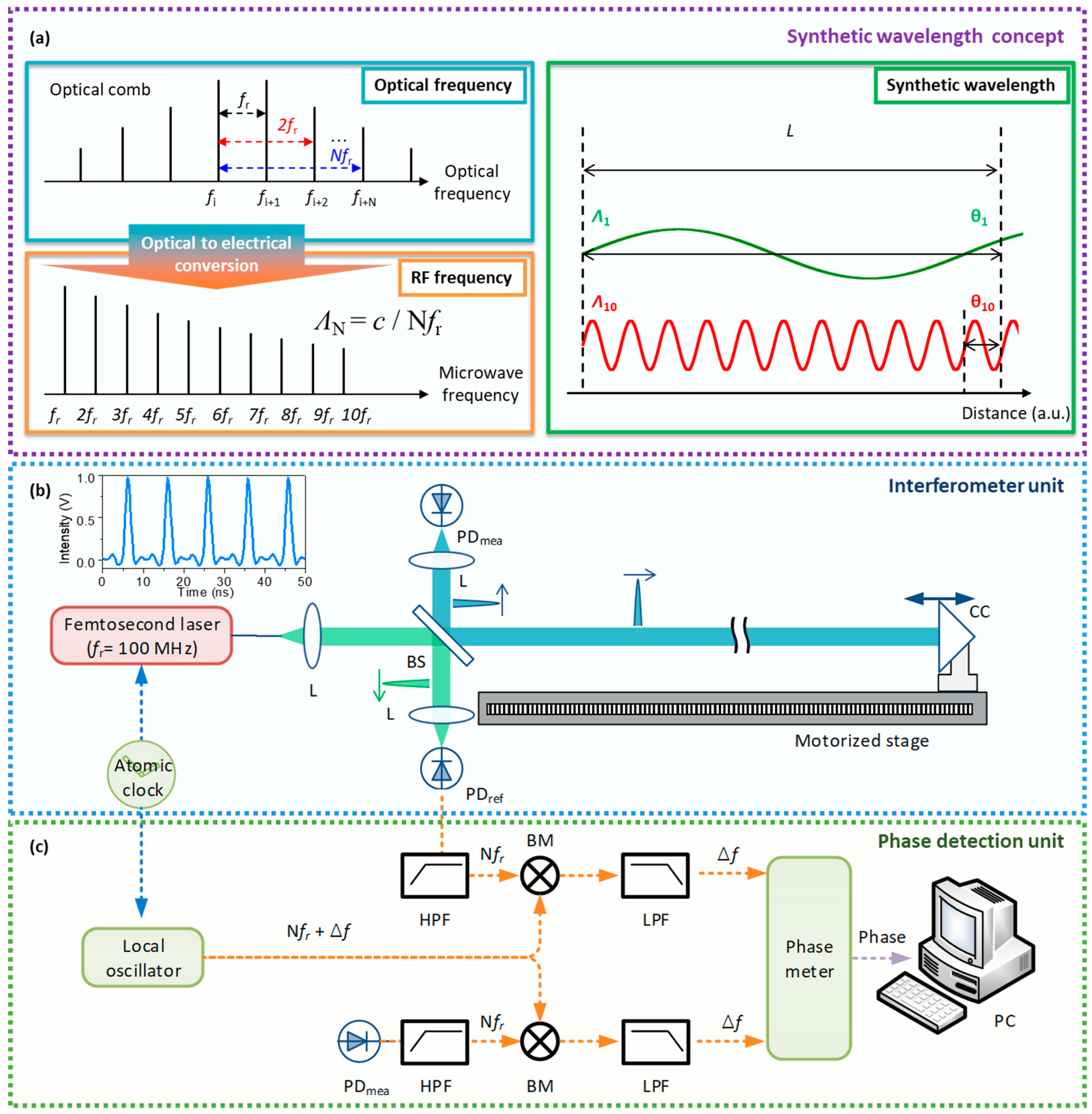Photonic Microwave Distance Interferometry Using a Mode-Locked Laser with Systematic Error Correction
Abstract
:1. Introduction
2. Photonic Microwave Distance Interferometer
2.1. Interferometer Configuration
2.2. Measurement Repeatability
3. Systematic Error Correction
3.1. Systematic Error Analysis
3.2. Passive Correction by Post-Processing
3.3. Active Correction by Compensating Optical Power
4. Conclusions
Author Contributions
Funding
Acknowledgments
Conflicts of Interest
References
- Gao, W.; Kim, S.-W.; Bosse, H.; Haitjema, H.; Chen, Y.L.; Lu, X.D.; Knapp, W.; Weckenmann, A.; Estler, W.T.; Kunzmann, H. Measurement technologies for precision engineering. CIRP Ann. Manuf. Technol. 2015, 64, 773–796. [Google Scholar]
- Berkovic, G.; Shafir, E. Optical methods for distance and displacement measurements. Adv. Opt. Photon. 2012, 4, 441–473. [Google Scholar] [CrossRef]
- Bobroff, N. Recent advances in displacement measuring interferometry. Meas. Sci. Technol. 1993, 4, 907–926. [Google Scholar] [CrossRef]
- Joo, K.-N.; Ellis, J.D.; Buice, E.S.; Spronck, J.W.; Schmidt, R.H.M. High resolution heterodyne interferometer without detectable periodic nonlinearity. Opt. Express 2010, 18, 1159–1165. [Google Scholar] [CrossRef] [PubMed] [Green Version]
- Fujima, I.; Iwasaki, S.; Seta, K. High-resolution distance meter using optical intensity modulation at 28 GHz. Meas. Sci. Technol. 1998, 9, 1049–1052. [Google Scholar] [CrossRef]
- Dale, J.; Hughes, B.; Lancaster, A.J.; Lewis, A.J.; Reichold, A.J.H.; Warden, M.S. Multi-channel absolute distance measurement system with sub ppm-accuracy and 20 m range using frequency scanning interferometry and gas absorption cells. Opt. Express 2014, 22, 24869–24893. [Google Scholar] [CrossRef]
- Dandliker, R.; Thalmann, R.; Prongue, D. Two-wavelength laser interferometry using superheterodyne detection. Opt. Lett. 1988, 13, 339–341. [Google Scholar] [CrossRef] [PubMed]
- Kim, S.-W. Metrology: Combs rule. Nat. Photon. 2009, 3, 313–314. [Google Scholar] [CrossRef]
- Jin, J. Dimensional metrology using the optical comb of a mode-locked laser. Meas. Sci. Technol. 2016, 27, 022001. [Google Scholar] [CrossRef]
- Jang, Y.-S.; Kim, S.-W. Distance measurements using mode-locked laser: A review. Nanomanuf. Metrol. 2018, 1, 131–147. [Google Scholar] [CrossRef]
- Minoshima, K.; Matsumoto, H. High-accuracy measurement of 240-m distance in an optical tunnel by use of a compact femtosecond laser. Appl. Opt. 2000, 39, 5512–5517. [Google Scholar] [CrossRef] [PubMed]
- Jang, Y.-S.; Kim, W.; Jang, H.; Kim, S.-W. Absolute distance meter operating on a free-running mode-locked laser for space mission. Int. J. Precis. Eng. Manuf. 2018, 19, 975–981. [Google Scholar] [CrossRef]
- Joo, K.-N.; Kim, S.-W. Absolute distance measurement by dispersive interferometry using a femtosecond pulse laser. Opt. Express 2006, 14, 5954–5960. [Google Scholar] [CrossRef] [PubMed]
- Van Den Berg, S.A.; Persijn, S.T.; Kok, G.J.P.; Zeitouny, M.G.; Bhattacharya, N. Many-wavelength interferometry with thousands of lasers for absolute distance measurement. Phys. Rev. Lett. 2012, 108, 183901. [Google Scholar] [CrossRef]
- Coddington, I.; Swann, W.C.; Nenadovic, L.; Newbury, N.R. Rapid and precise absolute distance measurements at long range. Nat. Photon. 2009, 3, 351–356. [Google Scholar] [CrossRef]
- Zhang, H.; Wei, H.; Wu, X.; Yang, H.; Li, Y. Absolute distance measurement by dual-comb nonlinear asynchronous optical sampling. Opt. Express 2014, 22, 6597–6604. [Google Scholar] [CrossRef]
- Lee, J.; Kim, Y.-J.; Lee, K.; Lee, S.; Kim, S.-W. Time-of-flight measurement using femtosecond light pulses. Nat. Photonics 2010, 4, 716–720. [Google Scholar] [CrossRef]
- Han, S.; Kim, Y.-J.; Kim, S.-W. Parallel determination of absolute distances to multiple targets by time-of-flight measurement using femtosecond light pulses. Opt. Express 2015, 23, 25874–25882. [Google Scholar] [CrossRef] [Green Version]
- Jin, J.; Kim, Y.-J.; Kim, Y.; Kim, S.-W.; Kang, C.-S. Absolute length calibration of gauge blocks using optical comb of a femtosecond pulse laser. Opt. Express 2006, 14, 5968–5974. [Google Scholar] [CrossRef]
- Hyun, S.; Kim, Y.-J.; Kim, Y.; Jin, J.; Kim, S.-W. Absolute length measurement with the frequency comb of a femtosecond laser. Meas. Sci. Technol. 2009, 20, 095302. [Google Scholar] [CrossRef]
- Jang, Y.-S.; Wang, G.; Hyun, S.; Chun, B.J.; Kang, H.J.; Kim, Y.-J.; Kim, S.-W. Comb.-referenced laser distance interferometer for industrial nanotechnology. Sci. Rep. 2016, 6, 31770. [Google Scholar] [CrossRef] [Green Version]
- Lee, J.; Lee, K.; Jang, Y.-S.; Jang, H.; Han, H.; Lee, S.-H.; Kang, K.-I.; Lim, C.-W.; Kim, Y.-J.; Kim, S.-W. Testing of a femtosecond pulse laser in outer space. Sci. Rep. 2014, 4, 5134. [Google Scholar]
- Lezius, M.; Wilken, T.; Deutsch, C.; Giunta, M.; Mandel, O.; Thaller, A.; Schkolnik, V.; Schiemangk, M.; Dinkelaker, A.; Kohfeldt, A.; et al. Space-borne frequency comb metrology. Optica 2016, 3, 1381–1387. [Google Scholar] [CrossRef]
- Kikuta, H.; Iwata, K.; Nagata, R. Absolute distance measurement by wavelength shift interferometry with a laser diode: Some systematic error sources. Appl. Opt. 1987, 26, 1654–1660. [Google Scholar] [CrossRef]
- Phung, D.-H.; Merzougui, M.; Alexandre, C.; Lintz, M. Phase Measurement of a Microwave Optical Modulation: Characterisation and Reduction of Amplitude-to-Phase Conversion in 1.5 μm High Bandwidth Photodiodes. J. Lightwave Technol. 2014, 32, 3759–3767. [Google Scholar] [CrossRef] [Green Version]
- Guillory, J.; Gardia-Marques, J.; Alexandre, C.; Truong, D.; Wallerand, J.-P. Characterization and reduction of the amplitude-to-phase conversion effects in telemetry. Meas. Sci. Technol. 2015, 26, 084006. [Google Scholar] [CrossRef] [Green Version]





Publisher’s Note: MDPI stays neutral with regard to jurisdictional claims in published maps and institutional affiliations. |
© 2020 by the authors. Licensee MDPI, Basel, Switzerland. This article is an open access article distributed under the terms and conditions of the Creative Commons Attribution (CC BY) license (http://creativecommons.org/licenses/by/4.0/).
Share and Cite
Kim, W.; Fu, H.; Lee, K.; Han, S.; Jang, Y.-S.; Kim, S.-W. Photonic Microwave Distance Interferometry Using a Mode-Locked Laser with Systematic Error Correction. Appl. Sci. 2020, 10, 7649. https://doi.org/10.3390/app10217649
Kim W, Fu H, Lee K, Han S, Jang Y-S, Kim S-W. Photonic Microwave Distance Interferometry Using a Mode-Locked Laser with Systematic Error Correction. Applied Sciences. 2020; 10(21):7649. https://doi.org/10.3390/app10217649
Chicago/Turabian StyleKim, Wooram, Haijin Fu, Keunwoo Lee, Seongheum Han, Yoon-Soo Jang, and Seung-Woo Kim. 2020. "Photonic Microwave Distance Interferometry Using a Mode-Locked Laser with Systematic Error Correction" Applied Sciences 10, no. 21: 7649. https://doi.org/10.3390/app10217649
APA StyleKim, W., Fu, H., Lee, K., Han, S., Jang, Y.-S., & Kim, S.-W. (2020). Photonic Microwave Distance Interferometry Using a Mode-Locked Laser with Systematic Error Correction. Applied Sciences, 10(21), 7649. https://doi.org/10.3390/app10217649







